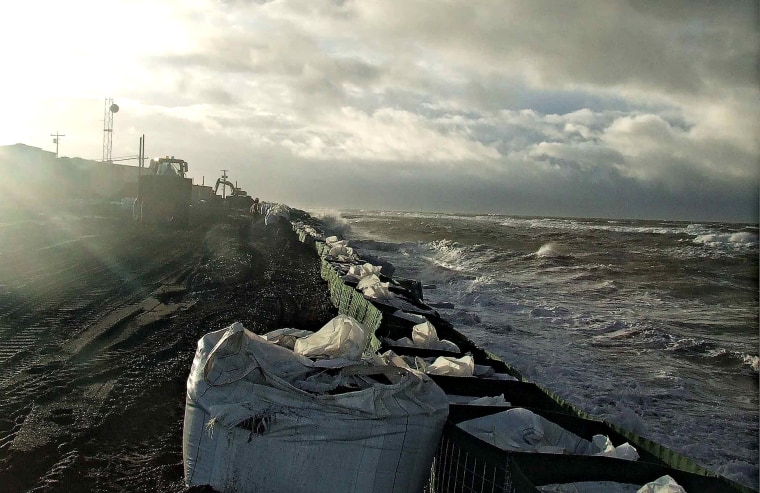More than half the residents of an isolated Arctic village were evacuated this week as storm surges threatened to flood their slender barrier island, the latest chapter in their losing battle against the sea.
With no road system within hundreds of miles of Kivalina, about 100 people, mostly seniors and children, boarded small propeller planes to the regional hub city of Kotzebue. More than 100 others embarked on a grueling 70-mile nighttime journey by boat, all-terrain vehicle and bus to shelter at the mountain headquarters of a zinc mine.
Most of the nearly 400 residents of Kivalina, an Inupiat Eskimo village in northwest Alaska, rely on fishing and hunting.
It was the only inhabited area under a flood warning along the Chukchi Sea this week, but is one of three villages along Alaska's storm-battered western coast that probably will have to be moved within the next 10 to 15 years because of erosion, according to the U.S. Army Corps of Engineers. The corps said in a report last year that it would cost up to $355 million to move Kivalina, Newtok and Shishmaref.
100 feet lost in 3 years
Kivalina, 625 miles northwest of Anchorage and 90 miles north of the Arctic Circle, has lost about 100 feet of coastline in the past three years to waves and storm surges, said tribal administrator Colleen Swan.
A $3 million sea wall built and rebuilt to protect Kivalina's roughly 600-foot-wide island is not keeping the water at bay, Swan and other villager leaders said.
"The people have lost their peace of mind," Swan said. "Since the village started eroding, we have lost a lot of land and people have become fearful of the fall storms."
While a single storm event cannot be attributed to global warming, experts say Arctic communities will start to see more erosion as the sea ice melts. The ice pack acts as a buffer from storms, but levels have fallen in the last 30 years and summer sea ice could disappear by 2050.
A storm last year tore away a portion of Kivalina's wall soon after it was completed, Swan said. On Thursday, nearly two dozen workers were shoring up weakened sections of the sea wall with sacks of sand and piles of gravel, said Vice Mayor Enoch Adams Jr.
Winds picked up by late Thursday, and waves washed away the beach at an area not protected by the wall, Adams said.
17-mile drive to shelter
The mass exodus began Wednesday night. Those who didn't fly to Kotzebue boarded small boats for the precarious channel crossing to the Alaska mainland. Once there, they loaded onto all-terrain vehicles big enough for several people and took a bumpy nighttime ride across 17 miles of gravel beach to the port of the Red Dog Mine. A bus shuttled them another 52 miles into the mountains to a gymnasium at the mine's headquarters.
Emmanuel Hawley said he spent 26 hours working on the sea wall crew and driving an all-terrain vehicle in an overnight rain shower, shuttling friends and relatives to safety.
Hawley said he and his parents and sisters don't plan on leaving Kivalina.
"I'm not scared of a wave," the 21-year-old said. "I have a job and I'm going to see what's going to happen next."
Swan, 48, said her six children and one grandchild escaped to the mine while she stayed behind to help monitor the storm.
"I think we'll be fine," she said, "but you never know."
